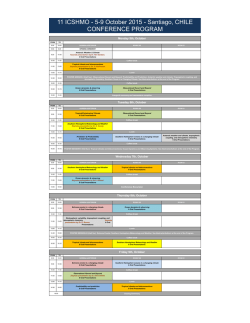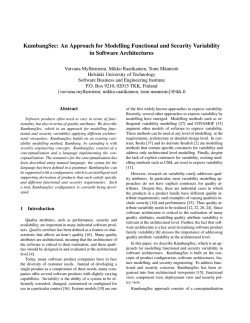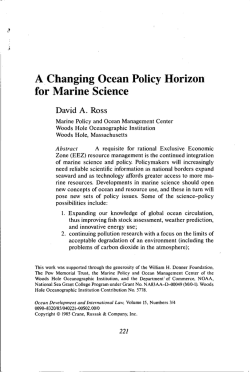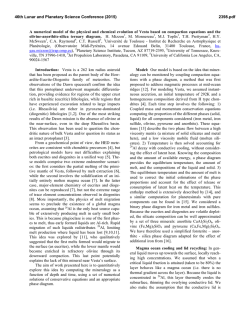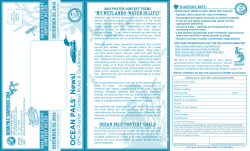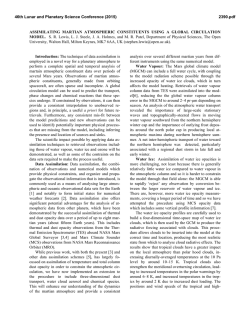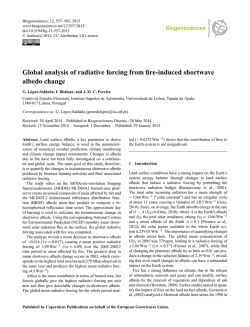
INTRINSIC OCEAN VARIABILITY SCIENCE DAY
INTRINSIC OCEAN VARIABILITY SCIENCE DAY January 29th 2015 Maison Jean Kuntzmann, Saint Martin d'Hères campus (here) The CHAOCEAN and OCCIPUT research projects concern the Low-Frequency Intrinsic Variability (LFIV) spontaneously generated by the eddying ocean. Both projects complement each other, and share several interests with partner projects (Turbulent Oscillator, MESO-CLIP, CAREER, …) and associated scientists. Our community probably has results, open questions, ideas and suggestions to share: this one-day workshop aims to gather scientists interested in the following questions, e.g.: - Simulation and detection of the oceanic LFIV (in simulations and in the real ocean). - Spatio-temporal features of the LFIV in idealized/realistic ocean models. - Origin of the oceanic LFIV (eddies, dynamical system theories, other?) and its sensitivity to atmospheric variability. - Implications of the oceanic LFIV for climate, observational oceanography, etc The list of registered participants may be found here (where you may register as well). Please send an email to Thierry Penduff if you want to submit a talk. This event will probably take place in Maison Jean Kuntzman (ground floor) in the same building as the Drakkar Workshop. This location will be confirmed on the 28th. 9:00: Welcome — Short introduction to the workshop Thierry Penduff, LGGE-MEOM, Grenoble, France 9:00 – 10:30 — INTRINSIC VARIABILITY IN OGCMS 1. Intrinsic variability in DRAKKAR 1/12° global simulations: Western boundary currents and AMOC. Guillaume Sérazin, Thierry Penduff, Laurent Terray, Bernard Barnier, LGGE – MEOM, Grenoble, and CERFACS, Toulouse, France. Ocean-atmosphere heat fluxes are particularly strong inWestern Boundary Current (WBC) regions where SST front variations influence basin-scale climate variability. Observed low-frequency fluctuations in latitude and strengh of these oceanic jets are classically thought to be essentially atmospherically-driven by wind stress curl variability via the oceanic Rossby wave adjustment. Yet academic eddy-resolving process-oriented models with double-gyre configurations have revealed that an idealized WBC may exhibit low-frequency intrinsic fluctuations without low-frequency external forcing (e.g. Berloff et al., 2007, Djikstra and Ghil, 2005, etc). Experiments with eddying Ocean General Circulation Models (OGCMs) have also shown that the amount of low-frequency Sea Level Anomaly (SLA) variability is largely intrinsic in WBCs over a wide range of spatio-temporal scales (Sérazin et al. 2015) and that the frontal-scale (< 10_) pattern of the Kuroshio Extension (KE) variability is similar to intrinsic modes (Taguchi et al. 2010). Based on a pair of atmospherically-forced 1/12°_ OGCM experiments that simulate with accuracy either the spontaneous generation of intrinsic variability (seasonally-forced) or the observed total variability (forced with the full range of atmospheric timescales), Empirical Orthogonal Function analysis is performed on zonallyaveraged SLA fields of four main WBCs (e.g. Gulf Stream, Kuroshio Extension, Agulhas Current and East Australian Current). The first two modes of the KE and GS exhibit a similar spatial structure that is shaped by oceanic intrinsic processes. The frequency content is however different between the intrinsic and total Principal Components, the former containing a wide range of timescales similar to a red noise and the latter being more autocorrelated at interannual-to-decadal timescales. These modes are compared with those obtained from the 20 years of altimetry observation and theoretical mecanisms are discussed. 2. An intrinsic ocean multidecadal mode Dewi Le Bars, Henk A. Dijkstra, Institute for Marine and Atmospheric Research Utrecht, The Netherlands We will describe an ocean mode of variability with a period of roughly 40 years that is found in a 200 years long simulation of the high resolution (0.1º) POP model under mixed boundary conditions. This mode spans over both hemispheres, with variations of the Atlantic Meridional Overturning Circulation, the Antarctic Circumpolar Current and the bottom water formation around Antarctica. It is able to store and release important amount of heat (60ZJ) as deep as 4000m in the AABW. 3. Resolution-dependence of the representation of surface flux characteristics in a series of ocean-only and coupled NEMO simulations. Pat Hyder (Met Office), John Siddorn (Met Office), Andrew Coward (NOC), Joel Hirschi (NOC), David Munday (Oxford University), and Chun-lei Liu (Reading University). We analyse a series of consistent 1, 1/4 and 1/12° ocean only NEMO-LIM simulations in conjunction with coupled 1 and 1/4o degree NEMO-CICE simulations. As expected, sea surface height variance, eddy kinetic energy, surface current speed and mean absolute vertical velocities all increase with increasing ocean resolution in the simulations. We compare the models both with CORE II fluxes and with observationally estimated monthly mean fluxes derived from top of atmosphere net fluxes minus ERA Interim total energy divergences (by University of Reading). Mean fluxes in the boundary currents appear to improve as the ocean resolution is increased. As expected, high frequency (< 2 month period) flux variability increases with ocean resolution in eddying regions in all simulations However, there appears to be increased variability at inter-annual periods in eddying regions in the 1/4 and 1/12° eddying ocean-only runs which is not evident the 1o parameterised eddy runs. These regions correspond to regions where ocean variability is known to be dominated by intrinsic ocean variability. This increased interannual variability at ¼° resolution compared to 1o is also evident in the coupled runs, which suggest that this intrinsic ocean variability may not be damped in a coupled system. We also examine fluxes composited by NAO states across the forced ocean-only models which also appear to show ocean resolution-dependent differences. The current Met Office seasonal forecast system, which uses a ¼° resolution ocean model, has considerably improved predictive skill for the winter mean NAO compared to a system employing a 1o resolution ocean model. Notwithstanding this, it also produces NAO signals with much smaller amplitude than the observed year-to-year fluctuations in the NAO. Planned coupled experiments with a 1/12° ocean model should help to determine whether further increasing ocean resolution might help to resolve this issue. COFFEE BREAK (10:30-11:00) 11:00 – 12:30 — INTRINSIC VARIABILITY PROCESSES 4. Role of synoptic atmospheric variability on intrinsic oceanic modes in the Pacific Terry O'Kane, CSIRO Castray Esplanade, Hobart, Tasmania, 7001, Australia South Pacific subtropical density compensated temperature and salinity (spiciness) anomalies are known to be associated with decadal equatorial variability, however, the mechanisms by which such disturbances are generated, advect and the degree to which they modulate the equatorial thermocline remains controversial. In order to investigate the role of atmospheric forcing on the generation and advection of spiciness we separated the intra- and interannual components of the winds from CORE2 forcing. CORE1 forcing was employed to determine the intrinsic oceans role in spiciness production in the southeastern Pacific and to identify possible teleconnections to the central equatorial Pacific. In a 100 year simulation of the intrinsic ocean we found a weak nonlinear oscillator localised in the central Pacific between 10°S–10°N due to Rossby–Kelvin wave interactions and with little evidence of spiciness production at higher latitudes. The importance of the oscillator, although weak, is as a mechanism intrinsic to the model that may be further excited by intra- or interannual atmospheric forcing. With the addition of the reanalysed ‘weather’ components (HFREQ simulations) subtropical Southeast Pacific spiciness anomalies are produced and then advected toward the central Pacific. These weather forced disturbances decay and so only weakly influence the central Pacific thermocline. The HFREQ experiments reveal a very realistic ENSO highly correlated with the observed frequency however, all El Nino events are central Pacific or “Modoki-like” events. The inclusion of the interannual atmospheric forcing results in spiciness anomalies that at particular times amplify and transition from passive to active (i.e. no longer density compensated) as they reach 15◦ S. A case study of the 2006–2007 El Nino shows while the “weather” is sufficient to produce an El Nino with warm waters localised in the central Pacific it is the interannual atmosphere that modifies the character of El Nino such that the warmest waters are located in the Eastern equatorial region corresponding to that observed. 5. North Atlantic Mode Waters, Eddies and Potential Vorticity William K. Dewar, Dept. of EOAS, Florida State University, Tallahassee, FL, USA Mode water maintenance from the perspective of potential vorticity dynamics is investigated using theoretical ideas and numerical models. It is argued that the anomalous potential vorticity structure of mode waters is not the result of anomalous potential vorticity inputs at the surface. Rather, they reflect a far simpler potential vorticity state in which the eddy field is an essential participant. This view is supported by both theory and models. 6. Intrinsic time scales of geostrophic turbulence related to bottom friction Antoine Venaille, CNRS/ Laboratoire de Physique, ENS Lyon, France We will present two exemples of low frequency signals in geostrophic turbulent flows. We will argue that bottom friction may play an important role in those two cases. One first example concerns low frequency variability of the mass transport of a barotropic anticyclonic recirculations taking place above topographic bumps surrounded with intense eddy activity (collaboration with J Le Sommer, J.-M. Molines and B. Barnier). In that case, a typical frequency of the system is given by the bottom friction coefficient. Below this cut-off frequency, the vortex dynamics integrates the white noise signal of the surrounding eddies into a red noise signal for the mass transport of the anticyclone. One second exemple shows a drastically different effect of botom friction. It concerns the dynamics of sharp surface intensified jets separating regions of homogenized potential vorticity (collaboration with L.-P. Nadeau and G. Vallis). We show that in a large bottom friction limit, the system is characterized by a typical frequency inversely proportional to the bottom friction coefficient: dissipation time scale increases with bottom friction. LUNCH (12:30-14:00) 14:00-15:00 — INTRINSIC VARIABILITY PROCESSES 7. Forced and intrinsic variability in the response to increased wind stress of an idealised Southern Ocean Chris Wilson, Joel Hirschi, Simon Mueller, NOC, Southampton, and UK MetOffice, Exeter, UK We use ensemble runs of a three-layer, quasigeostrophic idealized Southern Ocean model to explore the roles of forced and intrinsic variability in response to a linear increase of wind stress imposed over a 30-year period. We find that several intrinsic timescales influence the response. We find an e-folding timescale for growth of small perturbations of 1-2 weeks. The energy budget for intrinsic variability at periods shorter than a year is dominated by exchange between kinetic and potential energy. At longer timescales, we find an intrinsic mode with period in the region of 15 years, which is dominated by changes in potential energy and frictional dissipation in a manner consistent with that seen by Hogg and Blundell [2006]. A similar mode influences the response to changing wind stress. This influence, robust to perturbations, is different from the supposed linear relationship between wind stress and eddy kinetic energy, and persists for 5-10 years in this model, suggestive of a forced oscillatory mode with period of around 15 years. If present in the real ocean, such a mode would imply a degree of predictability of Southern Ocean dynamics on multi-year timescales. 8. Large deviation theory, rare events, and abrupt transitions, in geophysical fluid dynamics Freddy Bouchet, Joran Roland, Eric Simonnet, Tomas Tangarife, Jeroen Wouters, Laboratoire de physique, ENS Lyon, France. Many natural and experimental turbulent flows display a bistable behavior, in which one observes rare and abrupt dynamical transitions between two attractors that correspond to very different subregions of the phase space. The most prominent natural examples are probably the Earth magnetic field reversals (over geological timescales), the Kuroshio bistability, or the Dansgaard-Oeschger events that have affected the Earth climate during the last glacial period, and are probably due to several attractors of the turbulent ocean dynamics. Recent results show that similar bistability occurs also models of atmosphere dynamics. Those abrupt transitions are extremely rare events that change drastically the nature of the flow and are thus of paramount importance. By contrast with most theoretical models of phase transitions, for turbulent flows it is difficult to characterize clearly the attractors (they are not simple fixed points of a deterministic dynamics or statistical equilibrium states) and the trajectories that lead to transitions from one attractor to the others. The mathematical framework for the study of those phase transitions is being developed currently. We will review recent researches in this subject, including experimental and numerical studies of turbulent flows. Most of the talk will focus on theoretical and mathematical works in the framework of quasi-geostrophic models. We will also refer briefly to other stochastic partial differential equations. We will discuss predictions of phase transitions, the validity of large deviation results of the Freidlin–Wentzell type, or more involved approaches when the Freidlin–Wentzell approach is not valid. In quasigesotrophic models, the classical eddy-mean flow interactions are involved to trigger the rare transitions. The issue is then to understand and predict those eddy-mean flow configurations that lead to the rare fluctuations that trigger rare transitions. Applications to idealized and realistic models of the Earth atmosphere, and perspective for climate applications will also be discussed. 15:00-15:30 — INTRINSIC VARIABILITY WITH FULL FORCING 9. Intrinsic variability paced by external forcing: how can it be recognized in ocean models? Stefano Pierini, Dipartimento di Scienze e Tecnologie, Università di Napoli Parthenope, Naples (Italy) The variability occurring in a dynamical system is defined as intrinsic if it results from mechanisms internal to the system rather than from a slaved response to a time-dependent external forcing. To recognize intrinsic low-frequency variability in ocean models, steady or seasonal forcings are typically used. However, changes have been observed in ocean data that appear to be intrinsic according to the definition given above but that, at the same time, are paced by atmospheric lowfrequency changes: they can therefore be produced only by ocean models subject to interannual forcing. So, the problem arises as to how such form of variability can be recognized in outputs of ocean models driven by an interannually varying atmosphere. In this talk this issue is discussed by using both altimetric observations and model results, and open questions are outlined. COFFEE BREAK (15:30-16:00) 16:00-17:00 — INTRINSIC VARIABILITY WITH FULL FORCING (CONTINUED) 10. Intrinsic variability in seasonally-forced vs fully-forced OGCM simulations. Thierry Penduff, Guillaume Sérazin, LGGE – MEOM, Grenoble, France This presentation introduces some climate-relevant issues, open questions, and preliminary results about the low-frequency intrinsic variability that emerges from DRAKKAR OGCM simulations driven by two types of forcing: [1] constant (or seasonal) atmospheric forcing, i.e. with no lowfrequency atmospheric modes; [2] full range of atmospheric timescales, i.e. with direct influences of low-frequency atmospheric modes. The first approach is a simple way to isolate and characterize the low-frequency intrinsic variability with no direct atmospheric pacing; this reveals several features of the variability that the (autonomous) nonlinear ocean produces, but does not predict the possible influence of low-frequency atmospheric modes on such "eigenmodes". This latter influence may be diagnosed from the time-varying spread of ensemble simulations driven by a variable (realistic) atmospheric forcing: this is one of the main objectives of the ongoing OCCIPUT project. Preliminary ensemble OGCM simulations show that certain zero-order features of the intrinsic/stochastic variability isolated in the first approach persist under full reanalyzed forcing. 11. The OCCIPUT ensemble simulation: NEMO configuration and first results Laurent Bessières, Thierry Penduff, CERFACS-SUC, Toulouse and LGGE-MEOM, Grenoble. Academic models have illustrated the chaotic behavior of the ocean circulation at high Reynolds number, not only in terms of mesoscale turbulence but also in double-gyre or ACC-like current systems, up to decadal timescales. Unlike laminar ocean models used in most current climate projections, eddying OGCMs also spontaneously generate an substantial interannual-to-decadal variability under repeated seasonal forcing, with a stochastic character and a marked SST signature in regions where air-sea fluxes are maximum in Nature. Whether and how this ocean-driven lowfrequency intrinsic variability may ultimately impact climate predictability is an important but unsettled question. A preliminary step toward this question is to better describe the stochastic component of the low-frequency ocean variability, with a focus on climate-relevant indices. The OCCIPUT project aims at performing a 50-member ensemble of 1/4° global ocean/sea-ice NEMObased hindcasts driven by the same 1958-present atmospheric forcing. Reduced-size (10 members) North Atlantic preliminary simulations show that stochastically-generated initial perturbations spontaneously grow and cascade toward longer space-time scales, and that the ensemble spread saturates after a few months or years depending on locations and variables. These eddying ensembles do and will provide a probabilistic description of the ocean state and evolution over the last decades, and a measure of the actual constraint exerted by the atmosphere on interannual-todecadal ocean variability. This talk describes our ensemble model setup, numerical implementation on the CURIE supercomputer, and presents preliminary results in terms of physical solutions and ensemble statistics. 17:00-18:00: DISCUSSION (PHYSICS/IMPACTS OF INTRINSIC VARIABIITY, METHODOLOGIES, COLLABORATIONS) 19:30: DINNER DOWNTOWN GRENOBLE
© Copyright 2025

